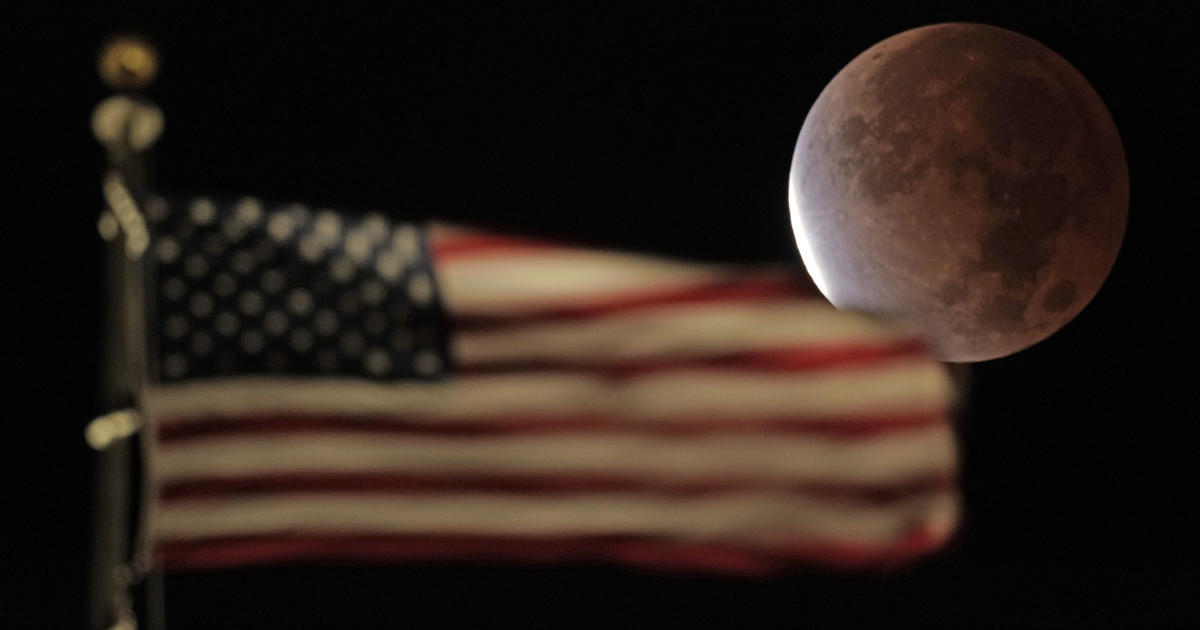
Stunning images of longest partial lunar eclipse since 1440
CBSN
The longest partial lunar eclipse in centuries was visible overnight across all of North America and parts of South America.
In this photo, the Earth's shadow covers the full moon during a partial lunar eclipse visible near a statue of George Washington atop Baltimore's Washington Monument, on Friday, November 19, 2021, in Baltimore, Maryland. A partial lunar eclipse is observed over Gifu Castle in Gifu, central Japan November 19, 2021. The Earth's shadow covers the full moon during the partial lunar eclipse as seen from Kansas City, Missouri. The partial lunar eclipse is seen above the Washington Monument in Washington, D.C. Earth's shadow falls on the moon during the partial lunar eclipse as seen from San Salvador, El Salvador, November 19, 2021. A partial lunar eclipse — also dubbed the "blood moon" — is seen behind the antenna on top of One World Trade Center in New York City, on November 19, 2021. A shadow falls on the moon as it undergoes a partial lunar eclipse as seen from Mexico City on November 19, 2021. The longest partial lunar eclipse in 580 years — lasting over 3 hours and 28 minutes — is seen in this series of images from the city of Bogota, Colombia. A partial lunar eclipse is observed in Sangju, South Korea, on November 19, 2021. The partial lunar eclipse, the longest in 580 years, as seen over the skyline of Charlotte, North Carolina. A view of the moon behind Zolotoy Bridge during a partial lunar eclipse visible over the bay of Zolotoy Rog in Vladivostok, Russia, November 19, 2021. A partial lunar eclipse is seen in the sky above Qingzhou City, in China's Shandong Province, November 19, 2021. The moon, with a partial lunar eclipse, is seen behind the writing "E Pluribus Unum," Latin for "Out of many, one," on the Statue of Freedom at the top of the dome on Capitol Hill in Washington, D.C. early on November 19, 2021. A seagull flies in the sky where a partial lunar eclipse is visible on November, 19, 2021, in A Corua'a, Galicia, Spain. A flag flies in the foreground as the Earth's shadow covers most of the full moon during a partial lunar eclipse on November 19, 2021, in Kansas City, Missouri. Visitors view the partial lunar eclipse from the Shibuya Sky observation deck at the Shibuya Scramble Square building, in Tokyo, Japan, on Friday, November 19, 2021.
This was the longest partial eclipse since 1440 — around the time Johannes Gutenberg invented his printing press — and won't be beaten until the far-off future of 2669. Space scientists said the moon would appear red, with the most vivid coloring visible at peak eclipse. Scientists said this partial eclipse would last more than 3 hours and 28 minutes. There will be a longer total lunar eclipse on November 8, 2022, NASA said. The longest partial lunar eclipse in nearly 600 years was visible in the early hours of the morning. The late November full moon is also known as the "frost moon." The longest total lunar eclipse occurred in 2018: 1 hour, 42 minutes and 57 seconds. Partial lunar eclipses occur when the moon does not pass completely into Earth's shadow. There will be 228 lunar eclipses this century, between 2001 and 2100. Most years will have two while some years will experience three or four. May 2021 saw a total lunar eclipse, so this marks the second eclipse this year. Most eclipses last less than two hours — so the 3 hours, 28 minutes and 23 seconds of this partial eclipse far surpasses others. NASA offered a livestream for watching the lunar eclipse. At its peak, the partial eclipse would cover almost 97% of the full moon's surface. Some sky-watchers with a cloud-free view saw the moon half covered by the Earth's penumbra, the outer shadow.

Washington — The Supreme Court on Thursday cleared the way for the Trump administration to deport a group of migrants with criminal records held at a U.S. naval base in Djibouti, clarifying the scope of its earlier order that lifted restrictions on removals to countries that are not deportees' places of origin.

 Run 3 Space | Play Space Running Game
Run 3 Space | Play Space Running Game Traffic Jam 3D | Online Racing Game
Traffic Jam 3D | Online Racing Game Duck Hunt | Play Old Classic Game
Duck Hunt | Play Old Classic Game










